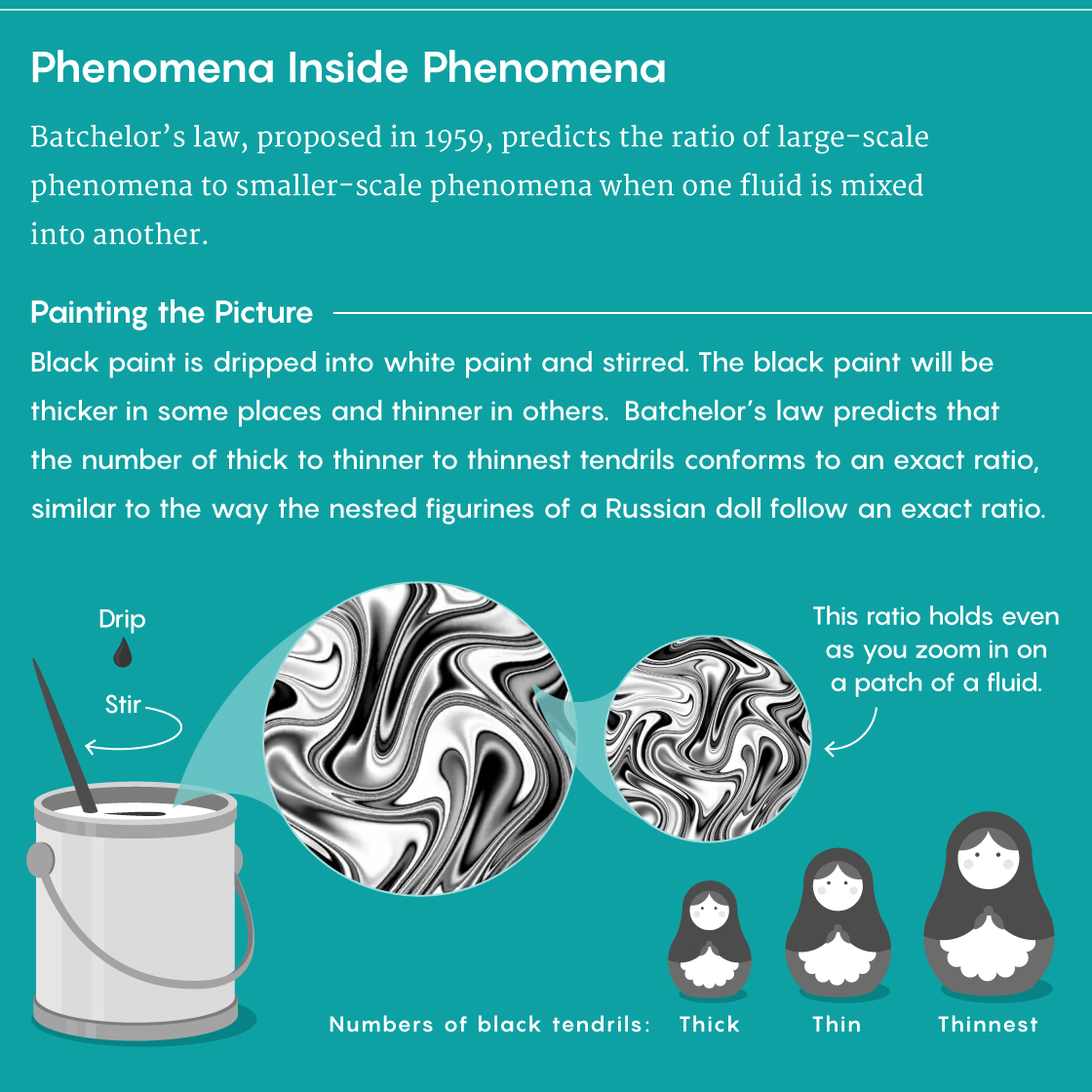Mathematicians Prove Universal Law of Turbulence

Mixing liquids and other turbulent systems have long been observed to follow a universal rule known as Batchelor’s law. Researchers have finally proved it mathematically.
Introduction
Picture a calm river. Now picture a torrent of white water. What is the difference between the two? To mathematicians and physicists it’s this: The smooth river flows in one direction, while the torrent flows in many different directions at once.
Physical systems with this kind of haphazard motion are called turbulent. The fact that their motion unfolds in so many different ways at once makes them difficult to study mathematically. Generations of mathematicians will likely come and go before researchers are able to describe a roaring river in exact mathematical statements.
But a new proof finds that while certain turbulent systems appear unruly, they actually conform to a simple universal law. The work is one of the most rigorous descriptions of turbulence ever to emerge from mathematics. And it arises from a novel set of methods that are themselves changing how researchers study this heretofore untamable phenomenon.
“It may well be the most promising approach to turbulence,” said Vladimir Sverak, a mathematician at the University of Minnesota and an expert in the study of turbulence.
The new work provides a way of describing patterns in moving liquids. These patterns are evident in the rapid temperature variations between nearby points in the ocean and the frenetic, stylized way that white and black paint mix together. In 1959, an Australian mathematician named George Batchelor predicted that these patterns follow an exact, regimented order. The new proof validates the truth of “Batchelor’s law,” as the prediction came to be known.
“We see Batchelor’s law all over the place,” said Jacob Bedrossian, a mathematician at the University of Maryland, College Park and co-author of the proof with Alex Blumenthal and Samuel Punshon-Smith. “By proving this law, we get a better understanding of just how universal it is.”
Turbulence All the Way Down
While the white waters of a choppy river aren’t the exact kind of turbulence at issue in the new proof, they are closely related and more familiar. So it’s worth thinking about them for a moment before turning to the specific kind of turbulence the mathematicians analyzed.
Picture a kitchen sink full of water. Open the drain. The water in the sink will start to rotate nearly as a single body. If you zoomed in on the fluid and measured its velocity at finer scales, you’d still observe the same thing — each microscopic portion of the fluid moves in lockstep with the others.
“The motion is predominantly at the scale of the sink itself,” said Blumenthal, a postdoctoral fellow also at the University of Maryland, College Park.
Now imagine that instead of merely draining the water, you pulled the plug while also adding water jets to the sink, churning it like a jacuzzi. With the naked eye, you might observe a handful of different vortices rotating in the water. Choose one of the vortices and zoom in on it. If you were a mathematician trying to analyze the flow of the turbulent sink, you might hope that every particle of water within that chosen vortex was moving in the same direction. This would make the task of modeling the fluid easier.
But alas, you’d find instead that the vortex is itself made up of many different vortices, each moving its own way. Zoom in on one of those and you’ll see that it, too, is made up of many different vortices, and so on all the way down, until the effects of internal friction (or viscosity) within the fluid take over and the flow smooths out.
This is a hallmark of turbulent systems — they feature distinct behaviors nested within each other at different scales. In order to fully describe the motion of a turbulent system, you need a picture of what’s going on at all of these scales at each moment in time. You can’t ignore any of them.
That’s a tall order, akin to modeling the trajectory of billiard balls using everything from Earth’s motion through the galaxy down to the interactions between gas molecules around the balls.
“I have to take it all at once, which is what makes it incredibly difficult to model,” said Jean-Luc Thiffeault of the University of Wisconsin, who studies turbulence.
As a result, mathematicians have spent decades trying to come up with a description of turbulence that specifies exactly what’s happening at every point in a turbulent system, at every moment in time. They haven’t succeeded.
“Turbulence is too hard for us to be able to do much about it directly, head on,” Thiffeault said.
That’s true for rushing rivers and draining sinks. It’s also true for the specific variant of turbulence in the new proof.
Mixing It Up
The sink and river are examples of hydrodynamic turbulence. They’re turbulent in the sense that the velocity of the fluid — its speed and direction — varies a lot from point to point. The new work is about other properties besides velocity that you can measure at each point in a fluid. To understand what that means, think about mixing paint.
Start with a container of white paint. Now add drops of black paint, one per second, stirring as you go. The first drop will land in the white paint and stand out like an island. But before long, it will start to mix into the white paint, elongating into finer and finer sinews. Subsequent drops of black paint will be in different stages of the same transformation: stretching, elongating, getting incorporated into the graying body of the paint.
In the same way that the velocity varies from point to point in the churning sink, the concentration of black paint will vary from point to point within the mixing paint: more concentrated in some places (the thicker sinews) and less in others.
This variation is an example of “passive scalar turbulence.” You can think of it as what happens when you mix one fluid, considered the “passive scalar,” into another — milk into coffee, say, or black paint into white.
Passive scalar turbulence also characterizes many phenomena in the natural world, like the dramatic temperature variations between nearby points in the ocean. In that environment, the ocean currents “mix” temperatures the way stirring mixes black paint into white.
Batchelor’s law is a prediction about the ratio of large-scale phenomena (thick tendrils of paint, or thick bands of ocean water at the same temperature) to phenomena at smaller scales (thinner tendrils) when a fluid is mixed into another. It’s referred to as a law because physicists have observed it in experiments for years.
“From a physics standpoint that’s good enough to call it a law,” said Punshon-Smith, a mathematician at Brown University. But prior to this work there’s been no mathematical confirmation that it holds absolutely.

Lucy Reading-Ikkanda/Quanta Magazine; Qizheng Yan and David Saintillan (UCSD) (insets)
To get a sense of what Batchelor had in mind, return to the paint. Imagine you’ve run the process for a while, adding drops of black paint as you stir. Now freeze the picture. You’ll see thick tendrils of black paint (paint that’s been stirred for the least amount of time), along with thinner tendrils (paint that’s been stirred longer) and even thinner tendrils (paint that’s been stirred even longer).
Batchelor’s law predicts that the number of thick tendrils, thinner tendrils and thinnest tendrils conforms to an exact ratio — similar to the way the nested figurines that comprise a Russian doll follow an exact ratio (in that case, one figurine per length scale).
“In a given patch of fluid, I’ll see stripes of different scales because some droplets have barely begun to mix, while others have been mixing for a while,” Blumenthal said. “Batchelor’s law tells you the distribution of the sizes of those stripes of black paint.” The exact ratio it predicts is complicated to describe, but thinner tendrils will be more numerous than thicker tendrils in an exact proportion.
The law predicts that the ratio holds even as you zoom in on a patch of fluid. You’ll see exactly the same relationship between tendrils of different sizes in the paint can and in a small patch of paint; if you zoom in more, on an even smaller patch, you’ll still see it. The pattern looks the same at every scale, just as it does in hydrodynamic turbulence, where each vortex contains other vortices.
It’s a powerful prediction that’s also very hard to model mathematically. The complicated nesting of phenomena at different length scales makes it impossible to exactly describe the emergence of Batchelor’s law in a single fluid flow.
But the authors of the new work figured out how to get around this difficulty and prove the law anyway.
A Random Approach
Bedrossian, Blumenthal and Punshon-Smith adopted an approach that considers the average behavior of fluids across all turbulent systems. Mathematicians had attempted this strategy before, but no one managed to implement it successfully.
The approach works because randomness sometimes makes it easier to make accurate predictions about the behavior of a system. Imagine a pegboard, like in a game show or arcade. Drop a coin from the top, and it will ricochet from peg to peg until it settles in one of many slots at the bottom. It’s difficult to predict exactly where a single coin will land — there are just too many factors influencing which way the coin will bounce at each peg.
Instead, you can treat the system as random — acknowledging that at each peg, there’s a chance the coin will bounce to the left and a chance it will bounce to the right. Get the probabilities right, and you can make accurate predictions about the behavior of the system as a whole. For example, you might find that coins are much more likely to land in certain slots than others.
“The nice thing about randomness is that you can do things like averaging,” Thiffeault said. “Averaging is a very robust idea in the sense that it doesn’t care about many of the details.”
So what does this mean for turbulence and mixing paint? Because exact, deterministic statements are beyond the reach of mathematics, it’s more useful to imagine that the forces acting on the paint occur at random — sometimes stirring it this way, sometimes stirring it that way, with no underlying pattern to the stirring. This is known as the random, or stochastic, approach. It allows mathematicians to adopt a high-level statistical view and to examine what happens in these types of systems in general, without getting bogged down in the specifics of every detail.
“A little randomness allows you to smear out the difficulties,” Punshon-Smith said.
And that’s what finally allowed the three mathematicians to prove Batchelor’s law.
Understanding Mixing
One way to prove a physical law is to think about the circumstances that would void the law. If you can prove those circumstances never happen, you back into proving that the law always holds. In this case, the team realized that the stirring would have to produce very specific effects to prevent the stripes predicted by Batchelor’s law.
Their proof of the law proceeds over four papers posted online between September 2018 and November 2019. The first three focused on understanding — and ruling out — particular motions in the mixing paint that would prevent Batchelor’s prediction from coming true. They proved that even if you tried to concoct a fluid perfectly engineered to defeat Batchelor’s law, the pattern would still emerge.
“The main thing to understand is that the fluid can’t conspire against you,” Bedrossian said.
For example, Batchelor’s law would fail if the mixing process produced permanent vortices, or whirlpools, in the paint. Those whirlpools would trap some black paint in one place — like debris trapped in a whorl at the edge of a stream — and the paint wouldn’t mix.
“Within a vortex like that, the particle trajectories are not chaotic; they don’t separate quickly, because they’re going around together,” Bedrossian said. “If your system is not mixing at the correct speed, you won’t get Batchelor’s law.”
In their first paper, the mathematicians focused on what happens during the mixing process to two points of black paint that begin the process right next to each other. They proved that the points follow chaotic paths and go off in their own directions. In other words, the nearby points can’t ever get stuck in a vortex that will keep them close forever.
“The particles move together initially,” Blumenthal said, “but eventually they split apart and go in completely different directions.”
In the second and third papers, they took a broader look at the mixing process. They proved that in a chaotic fluid, generally speaking, the black and white paint mixes as quickly as possible. This further established that the turbulent fluid doesn’t form the kinds of local imperfections (vortices) that would prevent the elegant global picture described by Batchelor’s law from being true.
In these first three papers, the authors did the hard mathematics required to prove that the paint mixes in a thorough, chaotic fashion. In the fourth, they showed that in a fluid with those mixing properties, Batchelor’s law follows as a consequence.
The proof is one of the strongest mathematically rigorous statements ever made about turbulent systems. Perhaps even more importantly, it opens the way for a new flow of mathematical insights. Turbulence is a chaotic phenomenon, nearly random in its motion. The three mathematicians figured out how to fight randomness with randomness. Others in the field will almost certainly follow their lead.
“Their big contribution is to give us a framework in which we can now prove things,” Thiffeault said. “I think randomness is one of the few ways of making a model of turbulence that mathematically we can understand.”
This article was reprinted on Wired.com.



